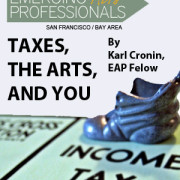 The Artist as Citizen
The Artist as Citizen
and Public Arts Partnerships
Tuesday, April 24, 2012
5-8pm
Intersection for the Arts
925 Mission Street, Suite 109, San Francisco (map)
FREE
Order tickets via Eventbrite
EAP brings together dynamic panelists to discuss artistic citizenship and issues of engagement with place.
For this program, among other inquiries, we ask:
* To what degree have artists become agents of community revitalization and place-making?
* How are cluster initiatives in the development of city spaces facilitating the role of artistic citizenship and providing opportunities for partnership with the public?
* In what ways are cities, curators, and organizations utilizing elements of the New Deal/ WPA legacy to create a new model for artists as citizens?
Panelists
David Kasprzak, Artist
Julio Morales, Artist / Adjunct Curator, Yerba Buena Center for the Arts
Jennifer Parker, Professor of Art and Digital Art and New Media, UC Santa Cruz / Co-founder, OpenLab
Randy Rollison, Innovation Studio Director, Intersection for the Arts
Lizzie Wallack, envelope architecture + Design / Project Architect, ProxySF
Moderator: Sanjit Sethi, Co-Director, CCA Center for Art & Public Life
5-5:30pm Networking
5:30-7:30pm Moderated discussion and Q & A
7:30-8pm Reception (light refreshments will be available)
Share this event on Facebook
This event is free and open to the public
Panelist Biographies:
David Kasprzak was raised in Knoxville, Tennessee. In 2000 he attended the Columbus College of Art and Design, Ohio, where he received his B.F.A. in Fine Arts. In 2003 Kasprzak was awarded a scholarship to Studio Art Centers International in Florence, Italy, where he focused on ancient art history and Italian cinema. During his stay in Italy, Kasprzak wrote and directed a feature length film titled Hitting The Same Car Twice. Upon returning to Columbus, Ohio, he began working for the Wexner Center for the Arts as a curatorial assistant and artist-in-residence. The final exhibition of his videos and sculpture was titled If Morning Never Comes (We’ll Be Just Fine). Kasprzak moved to San Francisco in 2005 to begin several curatorial endeavors, including organizing the group exhibition HYPERSPACES at Park Life, which presented the work of artists Sean McFarland, Paul Wackers, Orion Shepherd, and James Sterling Pitt. Kasprzak is currently pursuing his MA in Curatorial Practice at the California College of the Arts. His work has been exhibited in various galleries in California, Italy, Ohio, and Philadelphia, and often deals with subjects such as geometry, destruction, displacement, and paranoia in a humorous light.
Jennifer Parker is co-founder of Openlab and a Professor of Art and Digital Art and New Media at the University of California Santa Cruz. Parker’s research is rooted in sculpture, interactive art, new media, and kinetic art, including cross-disciplinary and collaborative research. Current projects explore new methodologies for art making that engage innovative, creative and collaborative research with art, community, design, technology, and science. Parker has exhibited internationally at a variety of venues including The War Memorial Museum in Seoul, Korea; the World Trade Center in Osaka, Japan; the Iskra History Museum in Kazanlak, Bulgaria; Califia Galerie and Skolska 28 Galerie in the Czech Republic. Locally Parker has exhibited, performed and presented at Yerba Buena Center for the Arts, SF Camerawork; The LAB; Gray Area Foundation for the Arts; Southern Exposure; SFMOMA; Kala Art Institute; and ZER01 Biennial in San Jose. Parker’s work has been supported by NASA California Space Consortium; Art Matters; the New Forms Regional Grant administered by the Inter-Arts Program of the NEA; and the University of California Institute for Research in the Arts.
Randy Rollison (Innovation Studio Director, Intersection for the Arts) has served in a leadership role in arts organizations in New York City, Cleveland and Portland, Oregon before joining the staff of Intersection in 2008. A graduate of New York University’s Tisch School of the Arts, he is an award winning producer, director and actor. He is known primarily for developing and producing the world premier of Eve Ensler’s “The Vagina Monologues”, which has had a global impact and proves that art does indeed have the power to change lives.
Born in Rochester, New York, Sanjit Sethi has done a residency at the Banff Centre in Alberta, Canada, as well as earned a master of science in advanced visual studies from the Massachusetts Institute of Technology’s Visual Arts Program in 2002. His work consistently deals with issues of nomadism, identity, the residue of labor, memory, and movement in the urban sphere—all of which involve various disparate social and geographic communities.Having completed a Fulbright Fellowship in India on the Building Nomads Project, Sanjit continued his strong focus on interdisciplinary collaboration while director of the MFA Program at the Memphis College of Art. His dedication to diverse forms of artistic practice extends in his new position as CCA’s chair of the Community Arts Program and codirector of CCA’s Center for Art and Public Life. Sanjit’s current work includes a collaborative project, titled Urban Defibrillation, the Gypsy Bridge Project, and the Kuni Wada Bakery.
Lizzie Wallack, Designer and Project Manager at envelope a + d, received her undergraduate degree in furniture design at the California College of Arts and Crafts in San Francisco. After a brief stint as a photo stylist back in Boston, she returned to (the newly re-branded) California College of Arts to explore her curiosities concerning the built environment, people, and space. Her Masters of Architecture included several competitive distinctions: Jury Prizes, Design Excellence Awards, and the highly regarded Thesis Prize. She will be teaching her first course at CCA this summer. She remains hungry to envision the future of design while bookmarking images of late ‘60s-early ‘70s muscle cars, which one day she will have…in white, of course.
 Wednesday, May 23, 5-7pm (reception to follow)
Wednesday, May 23, 5-7pm (reception to follow)








